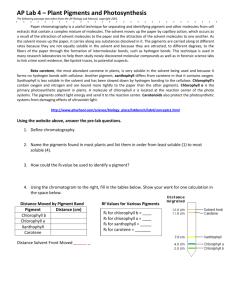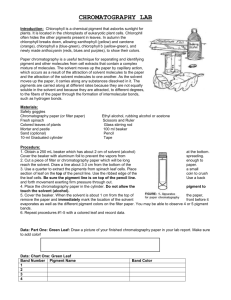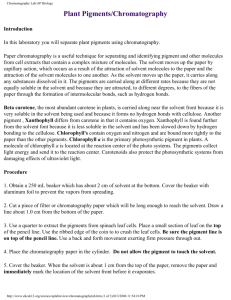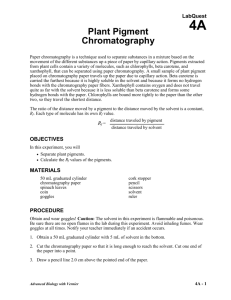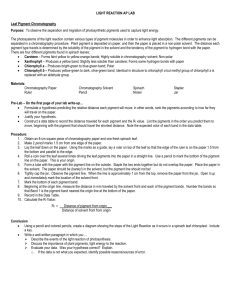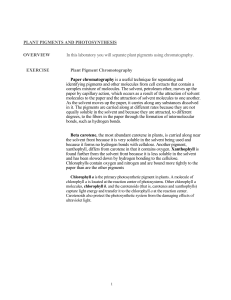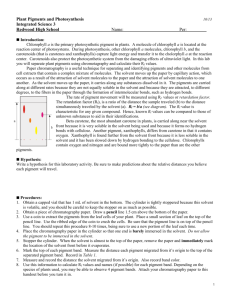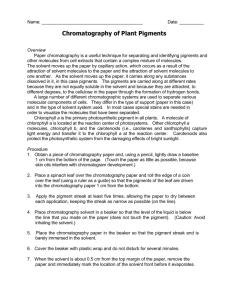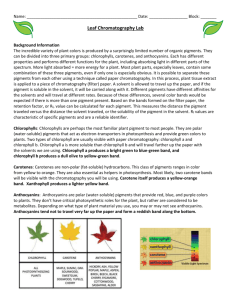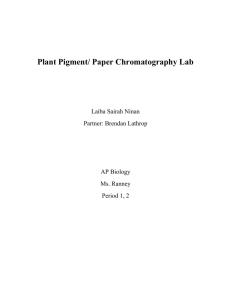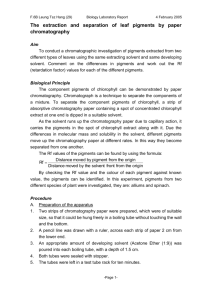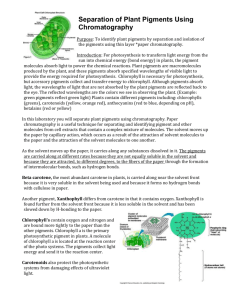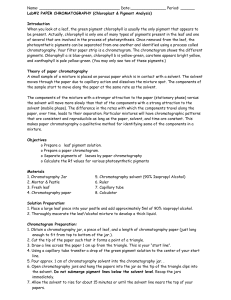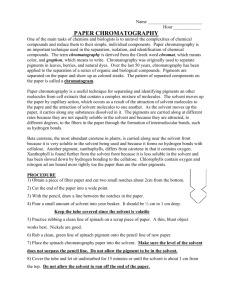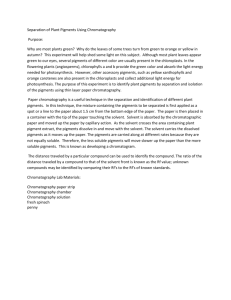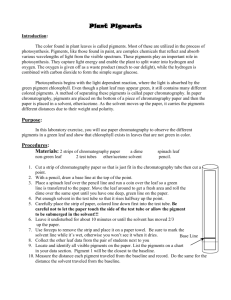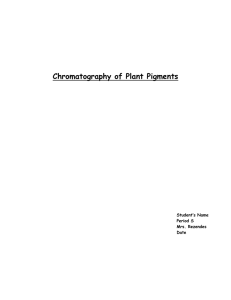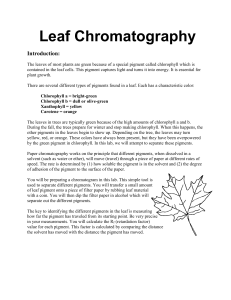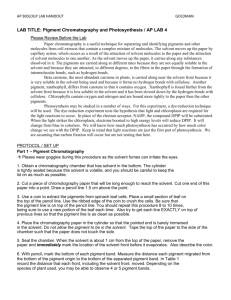Chromotography Lab
advertisement
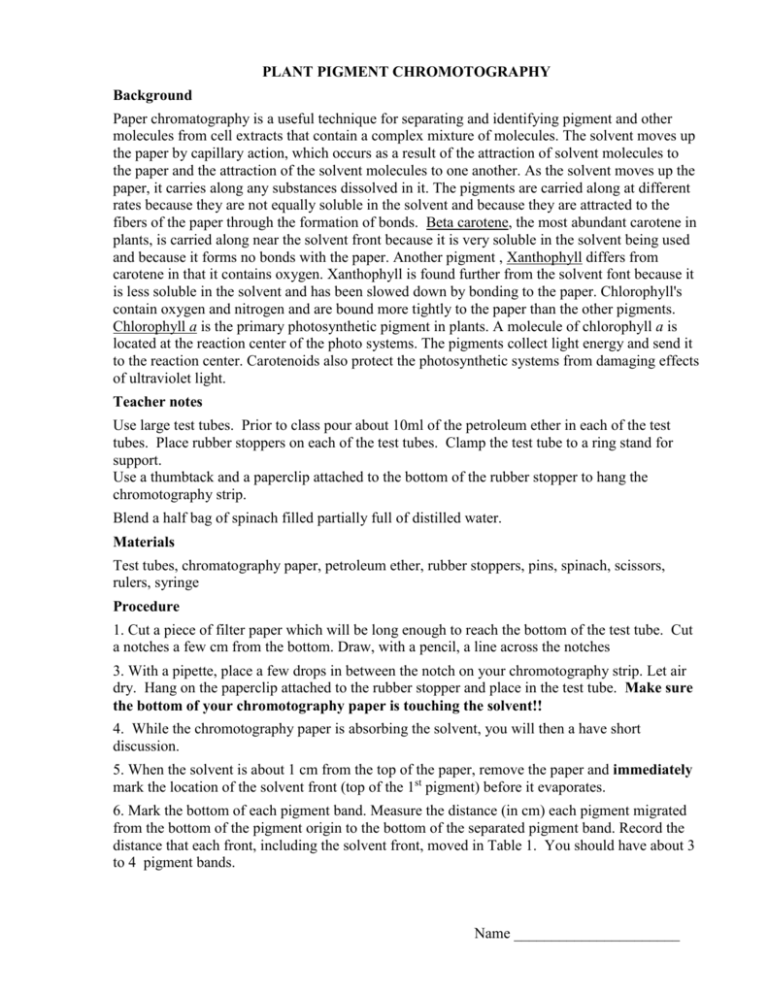
PLANT PIGMENT CHROMOTOGRAPHY Background Paper chromatography is a useful technique for separating and identifying pigment and other molecules from cell extracts that contain a complex mixture of molecules. The solvent moves up the paper by capillary action, which occurs as a result of the attraction of solvent molecules to the paper and the attraction of the solvent molecules to one another. As the solvent moves up the paper, it carries along any substances dissolved in it. The pigments are carried along at different rates because they are not equally soluble in the solvent and because they are attracted to the fibers of the paper through the formation of bonds. Beta carotene, the most abundant carotene in plants, is carried along near the solvent front because it is very soluble in the solvent being used and because it forms no bonds with the paper. Another pigment , Xanthophyll differs from carotene in that it contains oxygen. Xanthophyll is found further from the solvent font because it is less soluble in the solvent and has been slowed down by bonding to the paper. Chlorophyll's contain oxygen and nitrogen and are bound more tightly to the paper than the other pigments. Chlorophyll a is the primary photosynthetic pigment in plants. A molecule of chlorophyll a is located at the reaction center of the photo systems. The pigments collect light energy and send it to the reaction center. Carotenoids also protect the photosynthetic systems from damaging effects of ultraviolet light. Teacher notes Use large test tubes. Prior to class pour about 10ml of the petroleum ether in each of the test tubes. Place rubber stoppers on each of the test tubes. Clamp the test tube to a ring stand for support. Use a thumbtack and a paperclip attached to the bottom of the rubber stopper to hang the chromotography strip. Blend a half bag of spinach filled partially full of distilled water. Materials Test tubes, chromatography paper, petroleum ether, rubber stoppers, pins, spinach, scissors, rulers, syringe Procedure 1. Cut a piece of filter paper which will be long enough to reach the bottom of the test tube. Cut a notches a few cm from the bottom. Draw, with a pencil, a line across the notches 3. With a pipette, place a few drops in between the notch on your chromotography strip. Let air dry. Hang on the paperclip attached to the rubber stopper and place in the test tube. Make sure the bottom of your chromotography paper is touching the solvent!! 4. While the chromotography paper is absorbing the solvent, you will then a have short discussion. 5. When the solvent is about 1 cm from the top of the paper, remove the paper and immediately mark the location of the solvent front (top of the 1st pigment) before it evaporates. 6. Mark the bottom of each pigment band. Measure the distance (in cm) each pigment migrated from the bottom of the pigment origin to the bottom of the separated pigment band. Record the distance that each front, including the solvent front, moved in Table 1. You should have about 3 to 4 pigment bands. Name ______________________ PLANT PIGMENT CHROMOTOGRAPHY Table 1 Band Number 1 (furthest) 2 3 4 Distance moved by Pigment Band (millimeters) Distance (mm) Band Color eeeeeeeeeeeeeeeeeeeee eeeeeeeeeeeeeee eeeeeeeeeeeeeee eeeeeeeeeeeeeee eeeeeeeeeeeeeee eeeeeeeeeeeeeeeeeeeeeeeeeeeeee eeeeeeeeeeeeeeeeeeeeeeeeeeeeee eeeeeeeeeeeeeee Analysis 1. What factors cause the pigments to separate? ______________________________________ ______________________________________________________________________________ _____________________________________________________________________________ 2. What type of pigment is the most important in photosynthesis? _______________What are the roles of the other pigments?_______________________________________ 4. In what organelle do you find leaf pigments? _______________________________________ 5. What are the structures that make up the chloroplasts? ______________________________________________________________________________ 6. Many leaves change color in the autumn. How is it possible for this color change to happen? Base your answer on your new knowledge of pigments present in chloroplasts. (Hint: Chlorophyll a and b are easily broken down by the cooler autumn temperatures). ______________________________________________________________________________ ______________________________________________________________________________ ______________________________________________________________________________ 7. How do scientists use paper chromatography in their investigations? ____________________ ______________________________________________________________________________ ______________________________________________________________________________ 8. What causes color in plants or anything else? ______________________________________ ______________________________________________________________________________ 9. Explain this analogy: “Chlorophyll is like a battery, it gets charged in the sun.” ______________________________________________________________________________ ______________________________________________________________________________ 10. What color is used more than any other for Ps? _______________________ 11. What does a plant do with the photons absorbed by chlorophyll? _____________________________________________________________________________
